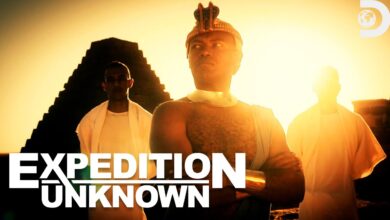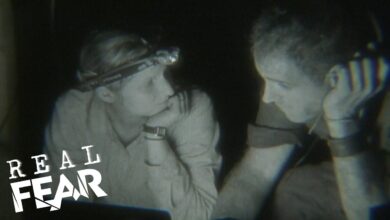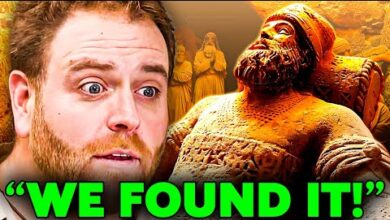Josh Gates & The Lost Ark Of The Covenant: Exploring A Secret Passageway l Expedition Unknown
Josh Gates & The Lost Ark Of The Covenant: Exploring A Secret Passageway l Expedition Unknown

The Ark of the Covenant is the single most iconic archaeological relic in history—an object of astounding religious significance and, according to legend, unimaginable power.
In the Old Testament, Moses returns from the top of Mount Sinai with stone tablets delivered from God Himself. On them are inscribed the Ten Commandments—an eternal covenant between man and the Almighty. These are kept in a sacred, gold-covered chest known as the Ark.
It is said to wield the terrifying power to consume its enemies with a wall of fire and reduce mountains to dust. The Israelites carry the Ark to Jerusalem, where it vanishes from history. Mankind has been looking for it ever since.
Archaeologist and my cinematic hero, the Ark is synonymous with adventure. But I won’t be fighting Nazis to find it. New excavations beneath the holy city of Jerusalem are revealing secret passages which may lead to the Ark’s last location.
It’s my turn to take on Indy’s quest as I join a new generation of raiders going after the Lost Ark.
Okay, so digging down into the rest of the Temple Mount isn’t going to happen anytime soon. But there is an archaeologist in town named Scott Stripling who may have a lead on another way to explore the underside of this city.
I meet Scott at the Tower of David, amidst the ruins of a massive citadel that once guarded the Old City.
“Scott,” I say. “Hey, Josh, how are you?” He greets me. “I’m good, man. Nice to meet you.”
“So, I know there’s a lot of people who believe that the Ark was hidden under the Temple Mount. Do you think that’s a possibility?”
“Well, I think it is, because the last place we know that it was, was here in Jerusalem. So this is a legitimate thing to explore. But since the 19th century, because of the political tensions and religious tensions, there’s been such little exploration done.”
“What brings you to the Old City today, then?”
“Well, I’ve been invited by some colleagues to check out an opening into the ground, and it seems like there’s a passage that is connecting to the Temple Mount area.”
“Wow, this is a literal hole in the ground, right? Has anyone gone down and surveyed this?”
“Not in modern times. It’s not documented, not published, and never been filmed, and that’s what we’re hoping to do today.”
Scott invites me to join him as he prepares to explore this mysterious hole in the ground.
I’m sorry, that’s the opening?
“Oh man, I should have skipped breakfast. I’m barely going to get in that.”
“You see the bottom?”
“Oh my God, it’s like 40 feet, more or less.”
“I will lower you down the beginning with this rope.”
“Just to understand this, you’re going to pull me out of this hole using that?”
“Yeah, consumer power drill.”
“It’s working?”
“You’ll be surprised.”
“Yes, I will be surprised. Okay, let’s see what happens.”
The shaft was concealed beneath ancient stonework, and because no one has been down there for hundreds of years or more, we can’t be sure the air is safe or that there is any air for that matter. We send down a meter to test how much oxygen there is for us to breathe.
“We don’t have any poison gas.”
“Just the air. It’s a bit thin.”
“A bit thin?”
“It’s right on the line. It will be more thinner because we are more people down.”
Once we get the green light to proceed, we tape our cuffs at the wrists and ankles to keep spiders and scorpions from doing their own excavations.
Finally, it’s time to go.
“Hooooly moly!”
I begin my descent through 3,000 years of history. “Here we go,” hoping that at the bottom lies a pathway that leads directly to the Ark of the Covenant.
“How’s it going down there?”
“Oh, it’s going great. Very old blocks all the way down.”
“Does the stone change from the top to the bottom?”
“It looks pretty consistent. The stone on the top is definitely first century. So if it’s consistent all the way down, then we know that this is a first-century shaft.”
“Copy that.”
“Looks like it’s opening up a little bit down here.”
“All good?”
“Okay, I’m definitely at the bottom. Lowering.”
“There’s a passage right behind you, Scott.”
“All right, here we go.”
We start to push forward into the tunnel. It’s pitch black down here, and the air feels thin. We’re joined by one of Scott’s team members, who’s equipped with supplemental oxygen.
“Notice how the roof is changing. These pavers have been laid here 2,000 years ago.”
“I’m positive now that this is a drainage system from the first century.”
“Wow. Any idea how far back it goes?”
“Well, further than I can see. We’re going in the direction of the Temple Mount.”
“Okay, let’s see where this thing goes.”
The size of these stones above us is incredible. “No, they’re massive. Remember, we’re about 40 feet under the modern city of Jerusalem right now.”
Some of the stones are holding up better than others.
“Looks like the lintel stone actually cracked.”
“Yeah, it is broken. Looks unstable, so don’t touch it.”
“Copy that.”
“As you’re coming in, stay low.”
“Little low. There you go.”
“All right, you made it.”
Things don’t get any more comfortable as we move in the direction of the Temple Mount. The further we go, the tighter the tunnels seem to narrow.
“Yeah, I’m pretty much hands and knees at this point. This is incredible, but also incredibly claustrophobic. This is as dangerous a place as I’ve been in a long time. The ancient tunnel is unstable, the air is barely breathable, and we’re down here with Jehovah knows what.”
“Oh, spiders!”
But at the end of it could be the Ark of the Covenant.
So there’s no thought of turning back.
“Oh my goodness, what’d you find?”
“You’re not going to believe what we’ve got here.”
“What do you got?”
“I can’t believe what I’m looking at—the signature of Conrad Schick, dated 1863.”
“Look at that!”
Conrad Schick was a famous 19th-century archaeologist, one of the few to explore under the Temple Mount before it became too volatile to dig.
“You can see clearly here, ‘Sea Ship.’ Now, the date’s a little rubbed out, but if we look back here, his companion has dated it 1863. That is outrageous! Can you believe that this man had the presence of mind 150 years ago to actually tag the wall so that we could find it and show it to the world?”
“Oh man, I knew I should have brought my can of spray paint.”
“You’re looking at history right now. This is a real creation. This is one of the tunnels that he discovered and surveyed.”
“Well, it’s positive proof. I mean, as an archaeologist, we dream about having inscriptions for evidence. Yeah, you couldn’t get any clearer than this.”
“This is awesome!”
“This is so awesome.”
“All right, man. Nice work, buddy. Excellent.”
“Okay, let’s see where this tunnel goes.”
Does this signature mean that these tunnels connect to those in the temple?
We have to push on, even as the walls close in on us, until there’s no further for us to go.
“Josh, we’ve come to a collapse.”
“Oh [ __ ], it’s blocked off. Looks like the tunnel actually does keep going, but another shaft has collapsed in.”
“Anywhere to sneak a camera through there?”
“I don’t see any way to get a camera through. Looks unstable.”
In the future, maybe we’ll be able to raise the money and come back and actually excavate this tunnel and see if it goes the rest of the way toward the Temple Mount. But for today, no Ark. Not today, my friend. We’re going to have to bring a team and come back and dig it right.
“Thank you.”
“Foreign.”








